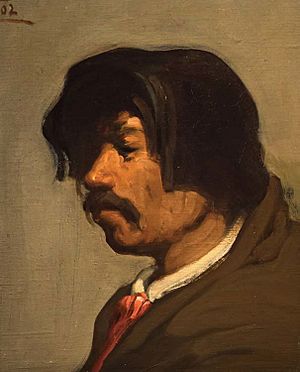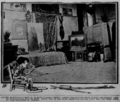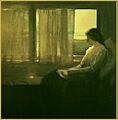Xavier Martínez facts for kids
Quick facts for kids
Xavier Martinez
|
|
|---|---|

Self-Portrait, 1902
|
|
| Born |
Javier Timoteo Martínez y Orozco
February 7, 1869 |
| Died | January 13, 1943 (aged 73) |
| Nationality | American (naturalized) |
| Other names | Xavier Tizoc Martinez, Marty Martinez |
| Education | California School of Design, Paris École des Beaux Arts |
| Known for | Fine art painting |
| Movement | California Tonalism |
| Spouse(s) | Elsie Whitaker Martinez |
| Patron(s) | Rosalia LaBastida de Coney, Alexander K. Coney |
Xavier Martínez (born February 7, 1869 – died January 13, 1943) was an important California artist. He was active in the late 1800s and early 1900s. He was known as a free-spirited artist in San Francisco, the East Bay, and the Monterey Peninsula. He also helped start two California artists' groups and an art gallery. He painted in a style called Tonalism, which uses soft, muted colors. He also made monotypes, etchings, and silverpoint drawings.
Contents
Early Life and Art Beginnings
Xavier Martínez was born in Guadalajara, Mexico, in 1869. His full name was Javier Timoteo Martínez y Orozco. Later, he changed his middle name to Tizoc to honor his Purépecha (an Indigenous Mexican people) background. His friends often called him "Marty."
From a young age, Martinez loved to draw. He would sketch his classmates and teachers while attending public school. After school, he worked in his father's bookstore. There, he learned how to bind books and help with printing. He also learned French and enjoyed writing poetry. He especially liked the poems of Goethe and Schiller. When he was ten, his mother taught him about the stars and planets. This made him realize there was a special order to everything.
When he was 13, he went to the Liceo de Varones, a grammar school for men. He studied ancient Mexican history and his Purépecha heritage. He was very good at drawing Native American designs and art. He even made an oil copy of a famous painting called Entombment by Titian.
Moving to San Francisco and Paris
When Martinez was 17, his biological mother passed away. He was then taken in by a kind woman named Rosalia LaBastida de Coney. She was married to Alexander K. Coney, an American who worked for Mexico's foreign office. In 1886, Alexander Coney became the Consul-General of Mexico in San Francisco. Martinez followed them to San Francisco, arriving in 1893.
In San Francisco, Martinez enrolled in the California School of Design. This school is also known as the San Francisco Art Institute (SFAI). In 1895, he won a special medal for his painting and an award for his drawing. He graduated in 1897 and briefly worked as an assistant. He also became a member of the Bohemian Club, a group for artists and writers.
In 1897, Martinez went to Paris, France, to study at the famous École des Beaux Arts. He sent paintings of Paris scenes back to San Francisco for an exhibition. He became friends with other artists, including Henri Matisse. He graduated in 1899. In 1900, his painting Portrait of Miss Marion Holden won an award at a big art show in Paris. This painting was in the Tonalist style, similar to a famous work called Whistler's Mother.
Returning to California and Mexico Trips
In 1901, Martinez moved back to San Francisco. He shared an art studio with another artist, Gottardo Piazzoni. That year, he became a citizen of the United States. He worked as a portrait painter but also continued to paint Tonalist landscapes.
In 1902, he helped start the California Society of Artists. This group was formed by artists who wanted to try new things. Martinez showed seventeen of his paintings in their first exhibition. In 1904, he began sharing his studio with artist Maynard Dixon. They often held art shows together on Saturdays. They traveled to Arizona and Mexico in 1905. After their trip, Martinez held several exhibitions of his new work.
He spent two months in Guadalajara, Mexico, with Maynard Dixon in 1905. When he returned to San Francisco, he had many exhibitions. He also had a show in New York, focusing on his recent paintings of Mexican life. That year, he created a painting that a critic called a "masterpiece." His poet friend, George Sterling, named it The Prayer of the Earth.
Family Life
After the big earthquake of 1906, Martinez moved to Piedmont, California. There, he met Elsie Whitaker, who was 20 years younger than him. She was the daughter of writer Herman Whitaker. On October 17, 1907, Xavier and Elsie got married in Oakland. After their honeymoon in Carmel-by-the-Sea, they started building an art studio in Piedmont.
From 1909 to 1914, they rented a house in Carmel during the summers. This allowed Martínez to teach art classes at the Hotel Del Monte.
Xavier and Elsie had a daughter named Micaela Martinez on August 13, 1913. Micaela also became a talented artist. She studied painting and sculpture. In 1944, she married artist Ralph DuCasse and changed her name to Micaela Martinez DuCasse. In 1923, Elsie and Xavier Martínez decided to separate.
Art and Teaching Career
In 1907, Martinez was one of the artists asked to create an art gallery at Monterey's Hotel Del Monte. In June 1909, he started teaching as a substitute drawing teacher at the California School of Arts and Crafts (CSAC) in Berkeley. By August, he became a permanent teacher, focusing on still life and landscape painting. He also wrote articles about art history for the school's magazine.
He taught at the California School of Fine Arts in San Francisco from 1916 to 1917. However, his contract was not renewed. The school's director did not like Martinez's "flamboyant attire and socialist-inspired commentaries." Martinez continued to teach at the CSAC. In 1924, the school moved to a new campus in Oakland. Three years later, he became a "Professor of Painting." He officially retired in September 1942. The school is now called the California College of the Arts (CCA).
From 1910 to 1914, he taught summer classes in the Monterey area. From 1915 through the late 1920s, he taught his summer classes from his studio in Piedmont. In 1912, he helped start the California Society of Etchers. The next year, he was elected to the National Geographic Society. Also in 1913, he went on a painting trip to the Arizona desert with Francis McComas (painter).
In 1914, famous Impressionist painters Childe Hassam and Edward Simmons visited Piedmont to see Martinez's desert paintings. The next year, he showed his work at the Panama Pacific International Exhibition and won an award. He also had shows in New York, Philadelphia, and San Francisco. Some of his well-known paintings from this time include Head of a Girl, The Storm, Piedmont Hills, and Lake Merritt.
Between 1916 and 1920, he had many exhibitions. Martinez became a member of the American Federation of Arts in 1921. He continued to exhibit his art, but he was also asked to be a judge for other artists' works. In 1935, he showed The Green Moon at the San Francisco Museum of Art.
In 1939, he exhibited Portrait of Elsie at the Golden Gate International Exposition in San Francisco. In 1940, Martinez was chosen to represent California in the Hall of Fame at the World's Fair of 1940 in New York. He was one of only three people chosen from California.
Writings
In the last twenty years of his life, Martinez became very interested in his Mexican heritage. He wrote poetry and philosophical articles in a column called "Notas de un Chichimeca." This column appeared in the Hispano-Americano, a Spanish-language newspaper in San Francisco.
Where to See His Art
Xavier Martinez's paintings are kept in several museums:
- Crocker Art Museum, Sacramento, California
- Fine Arts Museums of San Francisco
- Guadalajara Art Museum
- Mills College Art Museum
- Oakland Museum of California
Images for kids



